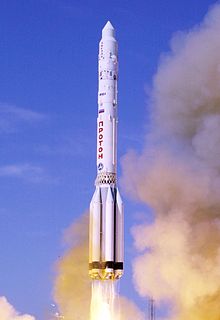
Back بروتون (عائلة صواريخ) Arabic Proton (raket) Azerbaijani Пратон (ракета-носьбіт) Byelorussian Протон (ракета) Bulgarian Proton Catalan مووشەکی پرۆتۆن CKB Proton (nosná raketa) Czech Protonraket Danish Proton (Rakete) German Protón (cohete) Spanish
 Launch of a Proton-K rocket | |
| Function | Orbital launch vehicle |
|---|---|
| Manufacturer | Khrunichev State Research and Production Space Center and Chemical Automatics Design Bureau |
| Country of origin | Soviet Union; Russia |
| Size | |
| Height | 53 metres (174 ft) |
| Diameter | 7.4 metres (24 ft) |
| Mass | 693.81 tonnes (1,529,600 lb), 3 stage |
| Stages |
|
| Capacity | |
| Payload to LEO | |
| Mass | 23,700 kilograms (52,200 lb)[1] |
| Payload to GTO | |
| Mass | 6,300 kilograms (13,900 lb)[1] |
| Associated rockets | |
| Derivative work |
|
| Launch history | |
| Status | Active |
| Launch sites | Baikonur, LC-200 & LC-81 |
| Total launches | 430
|
| Success(es) | 382
|
| Failure(s) | 44
|
| Partial failure(s) | 4
|
| First flight | Proton: 16 July 1965 Proton-K: 10 March 1967 Proton-M: 7 April 2001 |
| Last flight | Proton: 6 July 1966 Proton-K: 30 March 2012 Proton-M: 12 March 2023 |
| Type of passengers/cargo |
|
| First stage | |
| Powered by | 6 RD-275 |
| Maximum thrust | 10,470 kN (2,350,000 lbf) |
| Burn time | 126 s |
| Propellant | N2O4/UDMH |
| Second stage | |
| Powered by | 3 RD-0210 & 1 RD-0211 |
| Maximum thrust | 2,399 kN (539,000 lbf)[2] |
| Specific impulse | 327 seconds (3.21 km/s) |
| Burn time | 208 s |
| Propellant | N2O4/UDMH |
| Third stage | |
| Powered by | 1 RD-0212 |
| Maximum thrust | 630 kN (140,000 lbf) |
| Specific impulse | 325 seconds (3.19 km/s) |
| Burn time | 238 s |
| Propellant | N2O4/UDMH |
| Fourth stage – Blok-D/DM | |
| Powered by | RD-58M |
| Maximum thrust | 83.4 kN (18,700 lbf) |
| Specific impulse | 349 seconds (3.42 km/s) |
| Burn time | 770 s |
| Propellant | LOX/RP-1 |
Proton (Russian: Протон) (formal designation: UR-500) is an expendable launch system used for both commercial and Russian government space launches. The first Proton rocket was launched in 1965. Modern versions of the launch system are still in use as of 2023[update], making it one of the most successful heavy boosters in the history of spaceflight. The components of all Protons are manufactured in the Khrunichev State Research and Production Space Center factory in Moscow and Chemical Automatics Design Bureau[3] in Voronezh, then transported to the Baikonur Cosmodrome, where they are assembled at Site 91 to form the launch vehicle.[4] Following payload integration, the rocket is then brought to the launch pad horizontally by rail, and raised into vertical position for launch.[5][6]
As with many Soviet rockets, the names of recurring payloads became associated with the launch vehicle itself. The moniker "Proton" originates from a series of similarly named scientific satellites, which were among the rocket's first payloads. During the Cold War, it was designated the D-1/D-1e or SL-12/SL-13 by Western intelligence agencies.
Launch capacity to low Earth orbit is about 22.8 tonnes (50,000 lb).[7] Geostationary transfer capacity is about 6.3 tonnes (14,000 lb).[8] Commercial launches are marketed by International Launch Services (ILS).[9]
In 2013, the rocket was intended to be retired before 2030.[10] As of June 2018[update], production on the Proton rocket is ceasing as the new Angara launch vehicle comes on line and becomes operational. No new launch service contracts for Proton are likely to be signed.[11]
- ^ a b Khrunichev State Research and Production Space Center - Proton-M rocket // russianforces.org
- ^ "Proton 8K82K". www.friends-partners.org. Retrieved 26 June 2019.
- ^ АО "Конструкторское Бюро Химавтоматики" [JSC "Chemical Automation Design Bureau" (Khrunichev State Research and Production Space Center Homepage)].
- ^ "Site 92 in Baikonur Cosmodrome". russianspaceweb.com. Retrieved 26 September 2022.
- ^ "Proton Mission Planner's Guide". International Launch Services.
- ^ "Proton Verticalization, Pad 39, Baikonur". flickr. 5 September 2005.
- ^ Служебный модуль «Звезда» ['Zvezda' Service Module]. Khrunichev State Research and Production Space Center. Archived from the original on 16 April 2011.
- ^ Clark, Stephen (9 June 2016). "Upgraded Proton booster adds satellite to Intelsat's fleet". Spaceflightnow.com.
- ^ "Commercial Launch Heritage". International Launch Services.
- ^ "Russian rocket development in the 2010s". Anatoly Zak.
- ^ Cite error: The named reference
asr20100625was invoked but never defined (see the help page).
© MMXXIII Rich X Search. We shall prevail. All rights reserved. Rich X Search